Daring Bakers October: Savory Pot Pie--Mushroom and Veggie

Hannah of Rise and Shine was our October 2013 Daring Bakers’ hostess and she challenged us to bake our own double crusted savory pot pies. Using any from-scratch crust and filling we choose, we were allowed to get completely creative with our recipe, showing off the savory flavors and fillings from our own home or region.
I decided to make a mushroom and veggie pot pie.
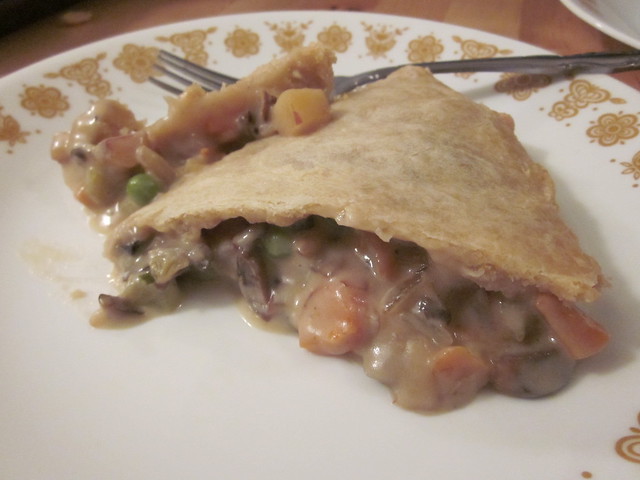
Although I had other names I called this pie while making and cutting it to serve.
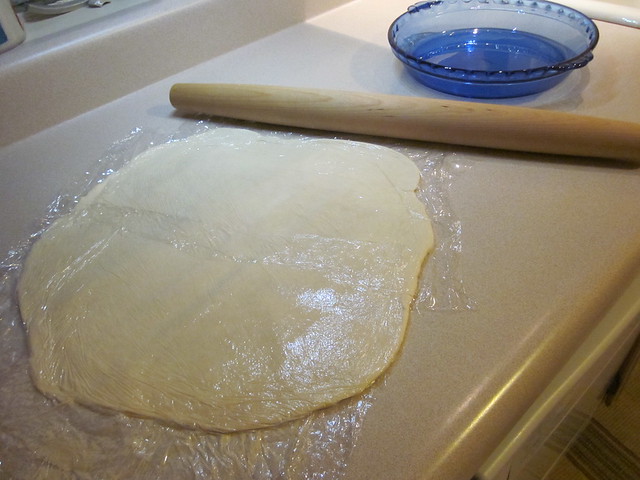
I hated the dough.
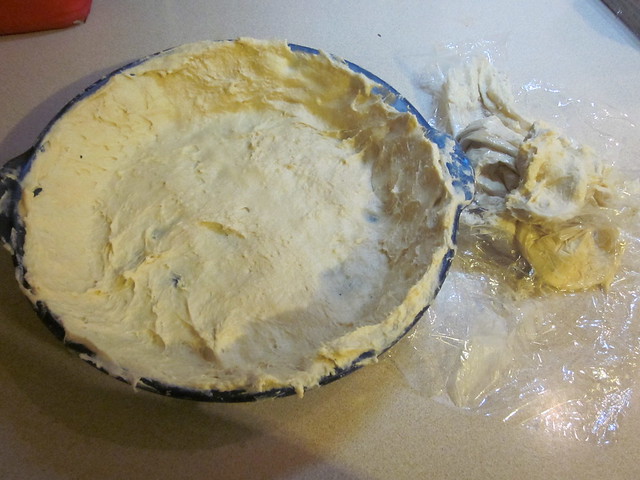
It wasn't so liquid that I could just pour it in and swish it into place.
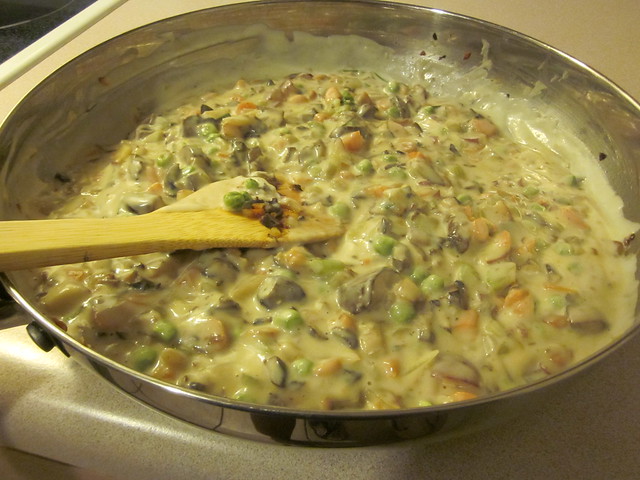
But I took comfort in the totally tasty filling.
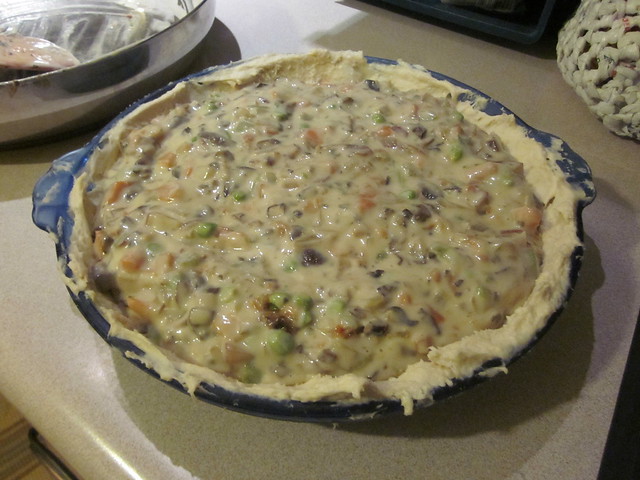 The filling filled the scary bottom crust.
The filling filled the scary bottom crust.
I used as much flour as I could to roll out the top crust without making it look like a sticky, tacky mess, but it still came out looking like Freddy Kreuger pie.

I was afraid the crust would totally deteriorate and drip off the top and over the sides, but it set up and stayed right where it was supposed to.
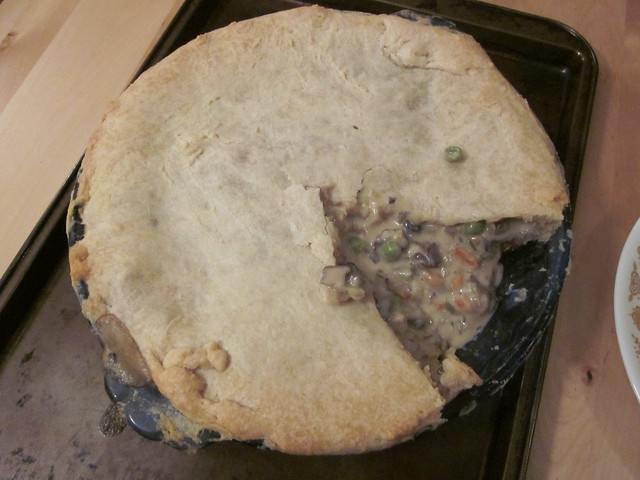
My puddle pie did set up after I let it cool a bit more, but even after cooling awhile, its filling still flooded out a bit when I started taking out slices.
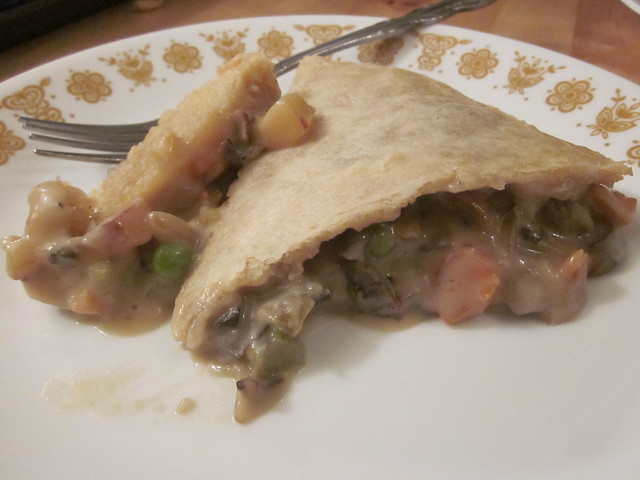
When all was said and done, deflated pie wasn't bad at all. The filling was tasty, but the crust was a pleasant surprise. I was afraid ti would be tough, but it was flaky and tender.
Notes:
A cup of water to a pie crust recipe using 3 1/2 cups of flour is way too much! I should've used just over half a cup, but I wanted to follow the recipe to the letter. Normally, I add the minimum amount of water called for and add more only if the dough doesn't come together. This recipe just called for a full cup of water.
Because the dough was so sticky, I kept it cold, and because it was so soft, it rolled out even though it was cold. I rolled it out between plastic, which made it easier to transfer to the pie plate. With typical pie dough, I don't have to flour the dough before laying plastic on it, but with this sticky stuff, I floured it because it stuck to the plastic. Awesome. *sigh*
For my filling, I used the pot pie recipe, but replaced 2 of the 3 cups of chicken with mushrooms and added an additional cup of vegetables.
Classic Chicken Pot Pie:
Servings: about 8 (one 9 1/2 inch (24 cm) pie)
Ingredients
Flaky Pie Crust:
3 1/2 cups ( 840 ml)(17 ¼ oz)(490 gm) all-purpose (plain) flour
1 tablespoon (15 ml) (½ oz) (13 gm) brown sugar, firmly packed
1 1/2 teaspoons (9 gm) salt
1/2 cup (120 ml) (4 oz) (115 gm) cold shortening (I always use butter flavored), cut into pieces
3/4 cup (180 ml) (6 oz) (170 gm) cold unsalted butter
1 cup (240 ml) ice water
Chicken Pot Pie Filling:
2 tablespoons (30 ml) vegetable oil
2 large carrots, peeled and diced
1 medium onion, diced
1/2 cup celery, diced
1/2 teaspoon (3 gm) salt
4 tablespoons (60 ml) (2 oz) (55 gm) butter, room temperature
1/3 cup (80 ml) (1 ½ oz) (45 gm) flour
2 cups (500 ml) chicken stock
1/2 cup (120 ml) half and half (half milk and half cream)
2 tablespoons (30 ml) white wine, light beer or chicken stock
1/2 teaspoon dried thyme
1/2 teaspoon black pepper
3 cups (750 ml) (15 oz) (425 gm) cooked chicken, chopped
1 cup (240 ml) (4½ oz) (125 gm) frozen peas, not thawed
Directions:
1. Mix flour, sugar and salt in a large bowl. Drop in shortening and quickly grate butter directly into the bowl using a cheese grater.
2. Using your fingers, a fork or a pastry cutter, work butter and shortening into the flour mixture until it's broken down into course, chunky crumbs. Stop mixing when the largest crumb is about the size of a pea.
3. Using a fork, quickly stir in very cold ice water. Turn the rough dough and crumbs onto a floured surface.
4. Knead just until dough starts to hold together in a rough mass, up to 10 times. Do not over mix! You will be able to see chunks of butter in the dough and this is a good thing.
5. Divide the dough in half and pat each half into a disk. Wrap each disk in plastic wrap and refrigerate for at least an hour before use. The dough will keep in the fridge for a full day, or you may freeze the dough for up to 3 months (and bring back to a thawed chill before rolling).
6. Preheat the oven to moderately hot 200°C/400°F/gas mark 6.
7. Heat oil in a wide bottomed skillet or sauce pan over medium-high heat. Add carrots and cook for 5 minutes, stirring often. Add onions, celery and salt and sauté until tender, about 5 minutes. Transfer to a medium mixing bowl and set aside.
8. Meanwhile, make a thick paste by mixing the butter and flour in a small bowl with a fork.
9. Heat 2 cups (500 ml) chicken stock in the empty skillet over medium-high heat. Drop the butter/flour paste into the stock and whisk vigorously until it come to a simmer. Boil briefly until thick like honey. Whisk in the half and half. Turn off heat, stir in wine, thyme and black pepper.
10. Stir together the cooked vegetables, chicken, peas and sauce.
11. Roll out one half of the chilled dough about 1/4 inch (5 mm) thick using a floured rolling pin on a well-floured surface. Once your round of dough is about ten inches (25 cm) across, dust the top with flour, pick the round up from the counter and dust under the dough again before rolling out completely to about 15 inches (38 cm) across. Hold your pie plate up to the round of dough to ensure it is large enough to fit your pie plate.
12. To set the dough into your pie plate, fold the round of dough in half, then in half again to create a large triangle of dough. Point the tip of the triangle of dough into the center of the pie plate and unfold. Be careful not to stretch the dough while you ensure that you have the dough tucked into all corners.
13. Pour the filling into the unbaked pie shell.
14. Roll out the top crust and cover the filling. Trim excess dough and seal the edge crust by folding the top dough layer under the bottom and pinching the dough together with your fingers or pressing with the tines of a fork.
15. Bake in the lower third of your oven until the pastry is golden brown, 45 to 50 minutes. To ensure the bottom is browned, you may choose to prop an electric oven open using the handle of a wooden spoon for the last ten minutes of the baking time. If at any point you fear the top crust is over-browning, cover with foil for the remainder of the baking time. Serve immediately while warm.
Check out my fellow DBers' projects by clicking through our blogroll.
Comments
Happy holidays -- love ya!